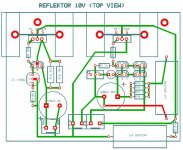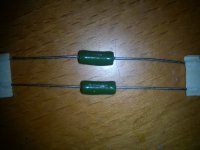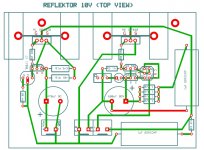Saturday Homework:
I want to have at least 220mA in the CCS so I am using 3r3 // 10r instead of 4r7 for R1.
R4 = 82r (I do not have such value so I will try 100r)
The 470u BG std on the input is good for decoupling.
R7 (0.22r) will be done with 4 x 1r (R7 a-d)
The output zobel cap (1u) is placed on the edge of the board so I can easily replace it (I want to try 220nF FT-3)
For C2 I will try 680u BGN that I have left over.
I would apreciate your oppinions on the layout and particularly on the Mosfet connections because I am not sure I got M2 Drain and Source well connected... Does M2 Drain go to F+ ?
I want to have at least 220mA in the CCS so I am using 3r3 // 10r instead of 4r7 for R1.
R4 = 82r (I do not have such value so I will try 100r)
The 470u BG std on the input is good for decoupling.
R7 (0.22r) will be done with 4 x 1r (R7 a-d)
The output zobel cap (1u) is placed on the edge of the board so I can easily replace it (I want to try 220nF FT-3)
For C2 I will try 680u BGN that I have left over.
I would apreciate your oppinions on the layout and particularly on the Mosfet connections because I am not sure I got M2 Drain and Source well connected... Does M2 Drain go to F+ ?
Attachments
Q1,Q2 reverse so they look to each one's face so you can bond them for same temperature. See they have the best hfe & Vbe matching also.
Thank you Merlin 🙂
You have e-mail.
I have a box full of 220nF FT-3... do you want some to experiment ?
You have e-mail.
I have a box full of 220nF FT-3... do you want some to experiment ?
Last edited:
Q1,Q2 reverse so they look to each one's face so you can bond them for same temperature. See they have the best hfe & Vbe matching also.
I will do that , thanks. What type of glue should I use ? Or can I use thermal compound and fix them with termal sleeve ?
Can I use metal film 220r for gate stoppers or should I go for CF ?
Is R3 2.2r determinant or can I use 1r8 ?
Last edited:
Gate stoppers MF OK, worked with other regs with comparable gain and frequency too. Have some space in case a base stopper for Q5 is going to be needed in the end, there is some layout distance that may demand it. No glue! Thermal grease and thin tie wrap or heat shrink sleeve.
1.8R looks safe (theoretically). If it proves very stable, we can look if it will be stable with only 220nF teflon zobel cap also. But don't start with too many changes, in case it will not go well, to know where to experiment step by step.
1.8R looks safe (theoretically). If it proves very stable, we can look if it will be stable with only 220nF teflon zobel cap also. But don't start with too many changes, in case it will not go well, to know where to experiment step by step.
Perfect... please have a look at the new layout (I will leave space for Q5 base stopper)
The changes I am asking for are only related with my stock of parts.
I can not buy anything now and must use whatever I have got 🙁
The changes I am asking for are only related with my stock of parts.
I can not buy anything now and must use whatever I have got 🙁
Thank you Merlin 🙂
You have e-mail.
I have a box full of 220nF FT-3... do you want some to experiment ?
Ricardo you have email, thanks for the couple of caps.🙂
Why not having the output Zobel to the right, nearer the output Mosfet, and the bypass cap at the bottom?
Good idea:
In this case I left place for the Q5 Base stopper (120r ?)
I compared this layout with the V1.2 and see that in that case the power mosfet has the Drain connected to F0.
In the Reflektor, the power mosfet Drain is connected to F+... Why ?
In this case I left place for the Q5 Base stopper (120r ?)
I compared this layout with the V1.2 and see that in that case the power mosfet has the Drain connected to F0.
In the Reflektor, the power mosfet Drain is connected to F+... Why ?
Attachments
I always try to post the correct questions so I tend get the full answers.
Thank you so much.
Thank you so much.
I have tried to implement a Salas shunt for providing the B+ of my Aikido LV, which runs on 24V. It contains 4 tubes, so current draw is less than 10 mA. Input voltage to the SS is 31V, which is on the low side, but should work I think, no?
Unfortunately, it doesn't work. The CCS works (the 3 leds light up, and I measured 2.3V across the 10Ohm resistor, giving 230 mA). However, the 2 leds for the shunt part don't light up, and output voltage is 0.
-What can be the problem? I have used the same board for 5V regulation and just changed the trimmer resistor and input voltage to make it 24V (which works when I disconnect the load).
- How can I troubleshoot?
thanks!
Unfortunately, it doesn't work. The CCS works (the 3 leds light up, and I measured 2.3V across the 10Ohm resistor, giving 230 mA). However, the 2 leds for the shunt part don't light up, and output voltage is 0.
-What can be the problem? I have used the same board for 5V regulation and just changed the trimmer resistor and input voltage to make it 24V (which works when I disconnect the load).
- How can I troubleshoot?
thanks!
Last edited:
Are you sure LED are proper oriented or are possibly damaged?
None of the above...
You should make sure that the available CCS current covers your load's need +20mA minimum. Sounds like the voltage setting section is current starved. Be it a dummy load or a real one. Heavy dummy load? Or there is a discontinuity in the sense lines.
- Status
- Not open for further replies.
- Home
- Amplifiers
- Power Supplies
- The simplistic Salas low voltage shunt regulator



